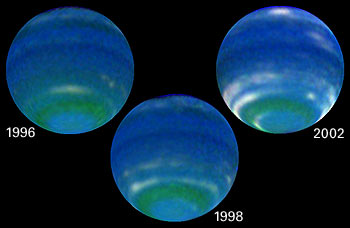| SPACE TODAY ONLINE COVERING SPACE FROM EARTH TO THE EDGE OF THE UNIVERSE | ||||||||||
| COVER | SOLAR SYSTEM | DEEP SPACE | SHUTTLES | STATIONS | ASTRONAUTS | SATELLITES | ROCKETS | HISTORY | GLOBAL LINKS | SEARCH |
Exploring Neptune:
It's Springtime on Planet Neptune
INDEX PLANET MOONS RINGS NEPTUNE PROBE SPRINGTIME RESOURCES
Astronomers looking out across the Solar System through NASA's Hubble Space Telescope recently were surprised to find an increase in the brightness of Neptune's southern hemisphere. They decided that was a harbinger of seasonal change.
Neptune has four seasons, of course, just like Earth. Each of its hemispheres have a cold winter and a warm summer. Fall and spring would be transitions as they are on Earth.
Unlike here on Earth, where each of our four seasons last three months, and it takes one year to travel around the Sun, the seasons out there on Neptune last for decades — decades!
That faraway planet takes almost 165 years to orbit the Sun, so one season lasts more than 40 years. That means the current spring continue to brighten the planet for 20 years.
Traveling bands. During six years of observations by scientists at NASA's Jet Propulsion Laboratory (JPL) in California and at the University of Wisconsin-Madison, bands of clouds floating across Neptune's southern hemisphere became brighter and wider.
The changes in the clouds followed seasonal variations in sunlight, just like seasonal changes we see on Earth, the astronomers noted.
Weird weather. The eighth planet out from the Sun, Neptune may be the coldest of the major planets. It's known for weird and violent weather. Fearsome winds sometimes gust to 900 miles per hour.
In 1996, 1998, and 2002, the Hubble Space Telescope showed ever-brighter clouds encircling the southern hemisphere. That supported earlier observations at Lowell Observatory at Flagstaff, Arizona, which showed Neptune brightening since 1980. Changes in the clouds also had been spotted by the Keck Telescope on Mauna Kea, Hawaii, in 2000 and 2001. NASA's Infrared Telescope Facility on Mauna Kea is checking further.
Why are there seasons? As Earth travels around the Sun each year, patterns of sunlight mark the seasons. Earth tilts toward the Sun at a 23.5-degree inclination. That is responsible for our change of seasons. Neptune also spins on an axis that is tilted at an angle toward the Sun. Neptune's inclination is a 29-degree angle.
The Sun is 900 times dimmer on Neptune than on Earth. The amount of solar energy reaching the planet is a lot less than Earth receives. Even so, sufficient sunlight arrives there to bring about seasonal changes.
When heat energy from the Sun strikes a planet's atmosphere, it forces a response. The hemisphere on Neptune getting the most sunlight at any one time would experience rising condensation and increased cloud cover.
Neptune continues to be an enigma that scientists suggest may also generate heat in itself. That could contribute to the seasonal variations. The planet was visited once, by Voyager 2 in 1989. Should we go back for another look?
The planet was visited once by Voyager 2, an unmanned robot probe from Earth, which flew within 3,100 miles of Neptune in 1989.
Should we go back for another look? »
Learn more:
NASA Solar System Exploration - Neptune »
Jupiter Icy Moons Orbiter (JIMO) proposed to fly in 2015 »
Neptune interplanetary probe proposed to fly in 2015 »
Read more about the Solar System . . . Star: The Sun Inner Planets: Mercury Venus Earth Mars Outer Planets: Jupiter Saturn Uranus Neptune Pluto Other Bodies: Moons Asteroids Comets Beyond: Pioneers Voyagers
| TOP OF THIS PAGE | NEPTUNE | SOLAR SYSTEM | STO COVER | SEARCH STO | QUESTIONS | © 2006 SPACE TODAY ONLINE |
